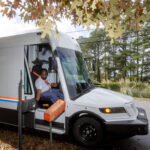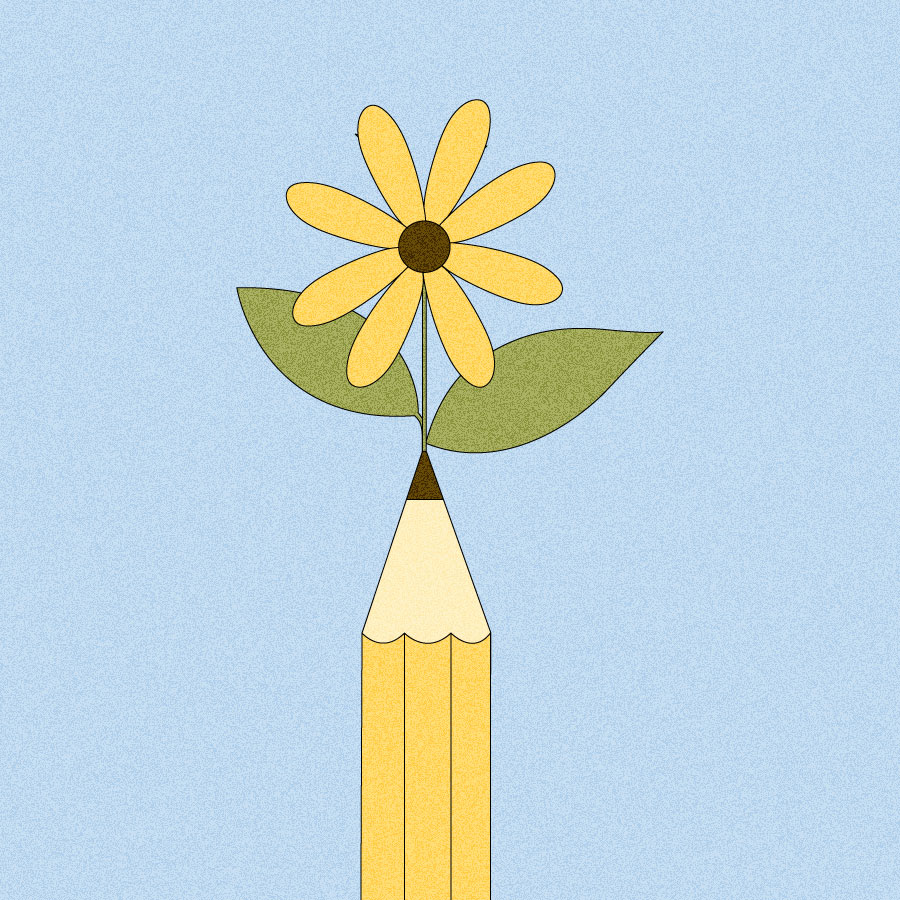The spotlight
Hey there, Looking Forward fam. In honor of our 100th newsletter last month, we launched a drabble contest, asking you to imagine the evolution of a single climate solution that excites you, 100 years from now. We are honored, and inspired, by the creative visions that so many of you sent in — the joyful, the poetic, and the slightly spooky. Enormous thanks to all who participated!
Today, I’m beyond thrilled to share with you our five winners. Each of these drabbles offers a little glimpse of a better future, based on real solutions that are being developed and implemented today.
Being able to picture a future worth living in — even a picture as small as what one can cover in 100 words — is a huge part of what keeps us energized and engaged in climate work in the present, and we often hear the same from y’all. (And, let’s be honest, right now we could all use a bright spot in the storm of global news.)
So without further ado, here are five doses of hope for our future, in no particular order. We’ve also gathered some resources for you to keep exploring the modern-day foundation of these solutions, if they inspire you as well.
The massive airship sways slowly in moor, its hull white against the sour iron gray of the oncoming storm clouds.
It landed on the small island just as a sudden storm swirled up from the warm waters of the Pacific. All around, sturdy seawalls, floating solar arrays, and kelp-farming scaffolds break the waves and wind.
All that infrastructure, and the hydrogen fuel station, were grant-funded decades ago by the global loss-and-damage fund. They reduce the devastating impact of typhoons and provide economic support to this island. It will never replace the coastlines, villages, and islands gone. But it’s a start.
— Betsy Ruckman
Betsy’s drabble was inspired by many climate solutions — but she wanted the focus to be one she views as a top priority: loss-and-damage funding.
The term “loss and damage” dominated the climate zeitgeist after COP27, the 2022 U.N. climate conference where delegates first agreed to set up a fund to provide financial assistance to the countries most affected by climate impacts, who have contributed the least to greenhouse gas emissions. Since then, countries have formalized some details about the fund but are still haggling over many more — including how the money will be disbursed (in the drabble, Betsy specifically chose grants, not loans) and how to raise enough to meaningfully address climate impacts.
Betsy attended COP27 as a student, and while she was there, she met Willy Missack, an activist from Vanuatu. “I was so blessed to talk with him for several hours at the conference, even though he was a party delegate and had much more official business to attend to,” Betsy said. “Willy has been pursuing clean water and resilient community buildings on Vanuatu for years, and his work directly inspired me to write about what success in loss and damage might look like on small island nations.”
More exposure
Read: more about the current status of the loss-and-damage fund (Grist)
Read: a Q&A with the climate minister of Vanuatu, one of the leading countries advocating for loss and damage and other international obligations around climate justice (Grist)
Read: an opinion piece explaining why loss-and-damage funding should be grant-based, not debt-based (Project Drawdown)
“Mom?”
Gia waits a beat while peeling back a corner of the wallpaper her rabbit had nibbled on.
“Mom!”
She hears nimble feet padding swiftly up the stairs. Her mother peers down at her from the doorway, brow furrowed.
“What’s this stuff in the walls, Mom? It moves!”
Gia pushes her fingertips into the textured beige surface peeking through pastel yellow. It gives slightly, then springs back.
Her mother snorts.
“They’re fungi roots, Gia.”
“Mushrooms? From the farm next door?”
“That’s right.”
For years afterwards, Gia would dream of pale, trembling tendrils inching across the floor and into her bed.
— Anika Hazra
“I was inspired to write a drabble about fungi because they can transform our built areas to function more like a self-sustaining forest ecosystem,” Anika said of her slightly eerie submission. “My drabble is meant to demonstrate a very real possibility in the near future where fungi will be used to decompose our current building materials and rebuild them into materials that are better for people, the environment, and climate.”
She was inspired by Mycocycle, a company that uses fungi to break down construction waste, then turns the resulting concoction into mycelium-based composites that can be used in new buildings. The process emulates the cycle of waste that would happen naturally in forests — mushrooms aid the decomposition of dead trees and other organisms, returning them to the building blocks of new life.
“Mycocycle is an example of biomimicry, which is the practice of developing solutions based on the structure or behavior of nonhuman organisms,” Anika shared, noting that she used to be a freelance writer for The Biomimicry Institute. “My passion for biomimicry runs deep!”
More exposure
Read: more about Mycocycle in AskNature, and about its founder, Joanne Rodriguez, on the 2023 Grist 50 list
Read: more about biomimicry, and its applications for climate solutions (GreenBiz)
Read: about the use of mycelium in sustainable building materials, as well as fashion, packaging, and other applications (Forbes)
Grandma says they used to call it “upcycling” or “downcycling,” or something. I guess they shortened it, because Naomi cycs her too-small pj’s for new ones that still smell right, I cyc worn running shoes, and even the chairs get cyced into whatever Willa wants. Real plastic is down to 10 percent of everything now. I look around: the basketball backboard, the clear bag, the detergent jug — my grandchildren will never know the word “biodegradable,” because there won’t be anything that isn’t. Willa and Naomi gather around me, our breath cycing into new air, new breath, new love every moment.
— Rani Jayakumar
Rani titled this drabble “Pretty Cyced.” In addition to playing with the evolution of language, she was inspired to write about the future of reusing, reducing, and recycling, in part because she grew up in a family that saved and repurposed “every last piece of plastic,” even before the three Rs had taken hold in the mainstream. But she was also inspired, in part, by science fiction. “I grew up watching Star Trek, where any item you want is replicated from atoms,” she said.
Rather than jumping ahead to a vision of a fully plastic-free future, she was interested in how technology could help us make better use of the stuff, as we gradually replace it with more sustainable materials.
“I’ve often wondered — even if we stop making plastic at this moment, what will we do with all that we already have?” she said. “The best solution, it seems to me, is to turn it into other things we need, or else return it to the hydrocarbons and the earth where it was formed, reminding us we are all forever interconnected on this planet.”
More exposure
Read: just how much current plastic recycling is falling short — and how petrochemical companies have continued to promote it anyway (Grist)
Read: about the latest negotiations on the global plastics treaty, due to be finalized at the end of this year (Grist)
Read: how some companies have begun to explore reusable packaging, and what more centralized systems of reuse could look like (also Grist)
The six of us stared at the long-faded swirls — blues, greens, and yellows that made Jacksonville’s last asphalt parking lot beautiful. Sarah, ramrod-straight in her wheelchair at 103, waved her huge old paintbrush at us.
“What’re you waiting for?” she called. “I’m growing old here!”
We hesitated. This was a slice of history: one of seven public art projects that had gone viral, unexpectedly attracting thousands. Jacksonville had become the Climate Rights Movement’s epicenter almost overnight.
“Take a piece home, if you’re so worried,” our grandmother said, her tone impatient with unplanted wildflower seeds.
I grinned and swung my sledgehammer.
— Kayla Benjamin
“The cli-fi drabble contest itself got me thinking about art and creativity as climate solutions,” Kayla told me. “I’d spent time in Philadelphia a few weeks earlier, and I saw a lot of gorgeous murals addressing ideas about social justice.”
She was struck by the question of what “success” would look like for activist art projects that aim to communicate a particular message. If that message was taken to heart, the meaning of the artworks would change. They would become relics of history — or objects to be destroyed, to make way for the types of changes that they helped champion.
And, she added, “I constantly walk around fantasizing about ripping up all the parking lots and building housing, green space, community centers, or literally anything else besides asphalt slabs.”
Those hot asphalt surfaces became both canvases for the artwork and, ultimately, targets of the local rewilding that she envisioned in her drabble. “It’s an art project that aims to make its own message obsolete,” she said, “and this scene is about that goal finally being achieved.”
More exposure
Watch: a video explaining the urban heat island effect, and how it disproportionately affects low-income neighborhoods of color (Grist)
Read: how some cities have begun to curtail their overabundance of asphalt by rethinking parking minimums (The New York Times)
Read: about eight artists using different mediums to communicate themes of climate and social justice (Yale Climate Connections)
What we did with the fifth day:
Slept in with the windows open. Held our lovers close, like commas. Watched light trickle and pool in the glass. Said hallelujah, thank you for all we got back. Watched tadpoles wriggle in the shallow silt of a city-stream, in a city-garden, in the city-green slumber of a fifth afternoon. Said, “Do they know what almost happened?” The tadpoles went on, not knowing the day of the week, or year, or the miracle of a tadpole and its little mouth, or how near we had come, or what we had come back from.
— Ro Rose
As the lead-in to this drabble suggests, its subject is the four-day workweek — or rather, the reclaimed time that is not spent working. In Ro’s vision, the unstressed inhabitants of a peaceful, green city are shown enjoying their time and their surroundings.
The climate benefits of working less range from the day-to-day emissions saved by slashing commutes to the broader implications of reducing production and consumption — part of the philosophy of degrowth. And advocates of the four-day workweek also tout the benefits for mental health and community well-being.
“I believe that a critical and underutilized climate solution is the reclamation of rest, simple pleasure, space, and time free of making or spending money,” Ro said. “If we were more willing to lie fallow, and to find empty space critical, we might be more comfortable with allowing our land and bodies to rewild.”
More exposure
Read: more about the four-day workweek, and its its implications for climate (Grist)
Read: about the physiological importance of joy and relaxation, and how prioritizing them can reduce burnout (Grist)
Read: about some of the health benefits of trees and green spaces in cities (Yale Climate Connections)
See for yourself
If these glimpses get your gears turning, try your own hand at envisioning a clean, green, just future! Put it in drabble form (a 100-word piece of fiction) and send it to the Looking Forward team absolutely anytime, at lookingforward@grist.org
Nothing makes us happier than hearing from y’all — especially when drabbles are involved. Although we aren’t always running contests like this, we have written newsletters inspired by drabbles and questions from readers, and we love getting to know what makes you curious, excited, and hopeful about our climate future.
This story was originally published by Grist with the headline Five creative visions for the future, from Looking Forward’s readers on May 22, 2024.
Announcing the winners of our first cli-fi drabble contest. Grist









